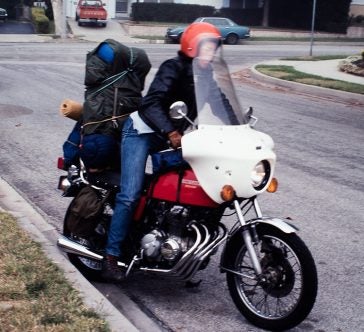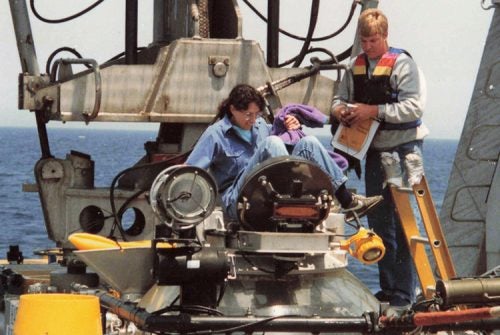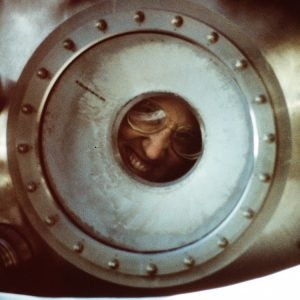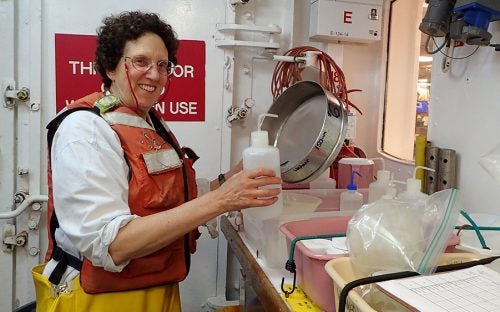Karen Wishner made a career of marine science, teaching and leadership.
By Ellen Liberman
In 1980, Karen Wishner rode into town on her Honda 400-4 Super Sport with a bedroll and her possessions bungeed on the back, like some outlaw biker science chick. Her new colleagues at the Graduate School of Oceanography were suitably impressed.
 “I remember how very fascinated I was,” recalls oceanography professor Candace Oviatt, who came to GSO in 1961 as one of the program’s first graduate students. “It said that she was truly an individual and a sort of a pioneering person to have the gumption to come across the country on a motorcycle as a woman. Not many women did that—not even now.”
“I remember how very fascinated I was,” recalls oceanography professor Candace Oviatt, who came to GSO in 1961 as one of the program’s first graduate students. “It said that she was truly an individual and a sort of a pioneering person to have the gumption to come across the country on a motorcycle as a woman. Not many women did that—not even now.”
This spring, she left. And after more than 40 years on the Bay Campus, Dr. Karen Wishner has kept her reputation for fearlessness and innovation—but as a scientist, a teacher and a force for gender equality.
“GSO is bigger—there’s certainly more women and more sophisticated technology and programs, with remarkable facilities, but it still has the same spirit,” she says. “It’s like Rhode Island—the feel of a small town—but with global reach and global expertise.”
Her influence runs deep. Wishner’s seminal work on ocean deoxygenation and zooplankton, begun in the 1980s, has taken on greater significance as climate change produces alarming drops in ocean oxygen levels. Her participation as co-principal investigator of a federal grant to hire more women faculty in engineering and the sciences paved the way for the current generation to advance along the tenure track in a different, more supportive culture. Karen Wishner’s name is literally woven into deep sea taxonomy. Researchers who used her samples named two zoo-plankton species after her: Chaetognath Heterokrohnia wishnerae and Copepod Parkius karenwishnerae.
Blazing her own trail
Wishner is the daughter of a scientist. She grew up in Wynnewood, Penn., the oldest of two girls. Her father, Julius Wishner was a psychology professor at the University of Pennsylvania, where he specialized in experimental psychopathology and schizophrenia. Her mother, Dorothy, was librarian at the Bryn Mawr Public library. The Wishners summered on the Jersey beaches and took family trips to Mexico and Europe.
“My parents were adventurous,” she says.
(And so was Karen—Wishner slept in the fields of Yasgur’s farm during Woodstock in 1969; passed through Sturgis during the rally—the nation’s oldest and largest gathering of motorcyclists; and cracked up with other courtroom spectators as Chicago Seven defendant Abbie Hoffman described his plan to levitate the Pentagon.)
A junior high school science teacher hooked her into biology, and in 1968, she matriculated at the University of Chicago for further study. In her sophomore year, her love of biology and adventure came together in one project that led to a lifelong investigation into lives of zooplankton. She joined marine biologist Franklin Barnwell’s fiddler crab study in Costa Rica, collecting buckets of crabs from their tidal burrows to measure their activity cycles in the lab. Her appetite for marine invertebrate biology grew during summer classes at the University of Oregon at Coos Bay and at a summer job at the Marine Biological Laboratory in Woods Hole. After graduation in 1972, she intended to follow her then-boyfriend to California, where he was studying at Stanford. But she wound up about 500 miles to the south. Wishner had applied to the University of California’s Scripps Institution of Oceanography in San Diego, and on a spring break, she checked it out.
“At the time La Jolla was active with seagoing ships, and I became convinced that the ocean was an up-and-coming field. So, I decided to go to Scripps not knowing what I was going to do. I meandered into dealing with zooplankton.
It was an era of paradigm-shifting discoveries in deep sea biology. By the time Wishner finished her Ph.D. on the biomass and ecology of the deep-sea benthopelagic plankton in 1979, she had developed and refined sampling techniques, becoming the first biologist to use a plankton net on the Deep Tow, an ocean geological survey system.
A career and a life at GSO begins
As a newly minted Ph.D., Wishner interviewed for several open academic jobs that year and accepted an offer from GSO.
“URI seemed like the nicest—an ideal place. I was excited when they offered the job. I was the first woman hired in an outside search for a tenure-track position. But I was really naïve in those days. I didn’t know how to order equipment or write a proposal. People were very helpful, but it was also very lonely. There was no cohort my own age, and a woman with a Ph.D. was an oddity.”
Wishner focused on the work that had brought her to Rhode Island. Over the course of her career, she has spent 25 months at sea on 19 different ships, documenting the conditions that affect zooplankton in bodies of water off both coasts, from the Gulf of Maine to the Antarctic, from the top of the water column to its depths.
 These investigations have been documented and analyzed in more than five dozen papers, but Wishner has some favorites. In 1988, Wishner recalls observing the dramatic change and abundance in sea floor animals linked to ocean oxygen levels through the porthole of Alvin as she sampled different depths along the seamount Volcano 7, in the eastern tropical Pacific. She was an investigator on the SCOPEX project, a series of cruises in 1988 and 1989 off George’s Bank, to study right whales feeding on dense swaths of copepods. And more recently, her 2017 expedition to the eastern tropical North Pacific Oxygen Minimum Zone, led to a paper, co-authored with GSO’s Dawn Outram and Chris Roman, and Brad Siebel of the University of South Florida, on the effects of slight changes in ocean oxygen levels on zooplankton. It won the Deep Sea Biology Society’s Paper of the Year award.
These investigations have been documented and analyzed in more than five dozen papers, but Wishner has some favorites. In 1988, Wishner recalls observing the dramatic change and abundance in sea floor animals linked to ocean oxygen levels through the porthole of Alvin as she sampled different depths along the seamount Volcano 7, in the eastern tropical Pacific. She was an investigator on the SCOPEX project, a series of cruises in 1988 and 1989 off George’s Bank, to study right whales feeding on dense swaths of copepods. And more recently, her 2017 expedition to the eastern tropical North Pacific Oxygen Minimum Zone, led to a paper, co-authored with GSO’s Dawn Outram and Chris Roman, and Brad Siebel of the University of South Florida, on the effects of slight changes in ocean oxygen levels on zooplankton. It won the Deep Sea Biology Society’s Paper of the Year award.
 “In all three of these cruises, we amplified each other’s work, doing something that wasn’t part of the proposal. We were always trying to go after other unique, unexpected things. Those were the fun cruises,” she says. “You have other big expeditions, with 80 principal investigators gathering an incredible amount of data, but there is virtually no flexibility. You had your time slot and that’s it. Those cruises are very intensive, but less serendipitous.”
“In all three of these cruises, we amplified each other’s work, doing something that wasn’t part of the proposal. We were always trying to go after other unique, unexpected things. Those were the fun cruises,” she says. “You have other big expeditions, with 80 principal investigators gathering an incredible amount of data, but there is virtually no flexibility. You had your time slot and that’s it. Those cruises are very intensive, but less serendipitous.”
A chief scientist or co-chief scientist on nine cruises, Wishner also inculcated her students in the rigors of shipboard science, the sampling protocols, and operating the equipment—and found time for a little fun.
“She’s got an adventurous part to her and it works with her science,” says Outram, Wishner’s long-time lab technician. “Some of the things we tried nobody had ever tried before.”
Some of Wishner’s fondest accomplishments were achieved on campus. She started an undergraduate course in deep-sea biology in 1994, at a time when the topic was considered only suitable for graduate work. In its 27th year, the course has attracted students with diverse academic interests, and inspired some to pursue marine-related careers.
“Some of those students will come up to me at some international meeting to tell me that they enjoyed my class,” she says. “I love that some went into deep-sea biology.”
Assistant Professor Roxanne Beinart, who co-taught the course, says that the creative assignments that engage students in developing hypotheses and designing experiments under Wishner’s personal guidance was one element of its success.
“The fact it’s at 8 a.m. and course enrollment fills up indicates how popular the class is. Karen is an excellent teacher and has put her heart into it,” she says. “Carrying it forward will be a challenge.”
Teacher, leader, mentor, friend
Carin Ashjian (Ph.D. 1991), a Woods Hole Oceanographic Senior Scientist and Biology Department Chair, says that Wishner was an inspiring advisor who taught her the ropes of science at sea.
“She was always there—attentive without being overbearing, and it sets students up to be independent researchers. When I was at GSO, she assured me that you can do anything,” says Ashjian, who now studies the distribution of zooplankton in polar regions. “Karen was never afraid to say things. She was very strong, leading by example. Early in her career, there weren’t very many women there, and they had to constantly prove themselves. It’s a fascinating sea change.”
The university that Karen Wishner joined in 1980 had few women faculty, paid them significantly less than their male counterparts, and afforded them fewer resources. In the mid-1980s, she and other female faculty got a pay boost after the American Association of University Professors challenged inequities in URI’s pay scale. In 2003, URI was chosen by the National Science Foundation’s ADVANCE program to receive a $3.5 million grant to hire nine female science, engineering and math professors (four at GSO). All are now full professors.
“Having a cohort with the same age and in the same situation—that makes a big difference,” Wishner, one of four co-principal investigators says. “We got the university to increase start-up funding for new faculty, which they used to pay almost nothing. The other thing that came from it was much more attention to work-life balance. We changed a lot of attitudes, and it was a major achievement besides my research.”
The science: first, last and always
 And her research goes on. Even as she was busy cleaning out her office and her lab, Wishner was still trying to get one more big manuscript out about copepod distributions in the Eastern Tropical Pacific Oxygen Minimum Zone, and has several more in progress.
And her research goes on. Even as she was busy cleaning out her office and her lab, Wishner was still trying to get one more big manuscript out about copepod distributions in the Eastern Tropical Pacific Oxygen Minimum Zone, and has several more in progress.
“When you look at the vertical distribution of zooplankton, they adjust based on the oxygen profile. They change their hibernation. There’s a lot of species-specific response and that affects the ecosystem of the food web. There’s a lot of complexity. It’s not a simple story, but we think we can use it to predict the future consequences of ocean deoxygenation effects.”
In retirement, she’ll be travelling to Long Island, where her husband, Tom Adams, works as an archivist for the Cold Spring Harbor Laboratory, and perhaps head to some international destinations, when COVID is finally under control. She still wants to go back to sea. “Hopefully, I’ll have a chance to participate on a modest scale. I know a lot about zooplankton.”
She laughs.
“I’m probably pretty helpful.”

